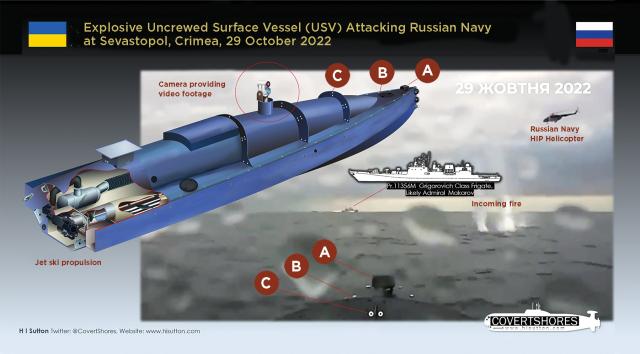H I Sutton
Ukraine’s attack on Sevastopol on 29 October 2022 will go down in history as the first major example of what many believe is a new era of drone warfare. The Russian Navy Black Sea Fleet found itself defending against both surface and aerial drones. Seven uncrewed surface vessels (USVs) were involved, along with nine uncrewed air vehicles (UAVs).
USVs have evolved quickly over the past few years, but only now have they truly gone to war. The surface drones approached the port in the early morning. They raced toward their targets, piloted remotely from hundreds of miles away using onboard electro-optical devices. On their bows, impact fuses would detonate the warheads.
The Russians were able to deal with some of the drones. Several drone’s-eye videos released by the Ukrainians and some spectator views shared on social media show a frigate firing its main gun at the drones. Some also show a helicopter using a door-mounted machine gun, which appeared at least partially effective. Yet at least one of the USVs—and likely more—penetrated the inner harbor.
Ultimately, the attack reportedly damaged two Russian warships. Although the fog of war is still thick (at least in the public domain), the USVs certainly did not sink any Russian ships. This does not mean the attack should be viewed as a failure. The Russian Navy now knows it is vulnerable in its main naval base, causing it to retreat further into its shell, increasing defenses and reducing activity outside.

A screenshot of a video released by Ukrainian forces with a diagram of the uncrewed
surface vessel that carried out an October attack on a Russian frigate.
The implications go further. Despite Russia having the more powerful navy on paper, these drones, combined with shore-based antiship missiles, mean Russia cannot enforce a stop-and-search blockade. After the attack, the Kremlin threatened to nullify a deal that allowed Ukraine to ship grain out of the country, claiming the shipping corridor had been used to hide the drones’ approach. While Russia was willing to attack merchant ships in the opening days of the war, doing so now would be politically difficult. So, Russia did a U-turn and rejoined the deal, because it did not have the political means to sabotage it.
In some respects, the Ukrainian attack played out similarly to what Western navies have been preparing to defend against for years. The 2000 USS Cole (DDG-67) bombing, Iran’s mosquito fleet, and some similar attacks off Yemen have led to the development of better close-in defenses. Western navies might have fared much better under similar circumstances, but, even so, they cannot be complacent.
Ukraine’s drones are very different from the USVs being developed by navies around the world. USV programs have concentrated on unarmed missions—for example, surveillance, mine countermeasures, and intelligence. More ambitious projects have included weapons, but these have been largely for defensive missions. Now, like the weaponized UAVs that started as ISR platforms and soon became cheap smart bombs, USVs are moving into offensive warfare.
Future wars may see increased use of weaponized surface drones. Individually, they may pose only a limited danger, but their low cost and the low risk associated with their use likely will lead to them becoming a persistent threat. They may shape future wars just as their aerial counterparts are already doing. But will leading navies accept the obvious lessons and initiate similar low-cost armed USVs?
No comments:
Post a Comment